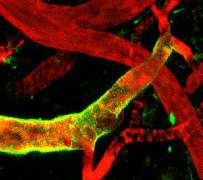Dendritic cells control lymphocyte entry into lymph nodes

Dendritic cells, discovered in 1973 by Ralph Steinman (2011 Nobel prize in Physiology or Medicine) and known for their role as sentinels of the immune system, have an essential function in the development of high endothelial venules (HEVs), acting as genuine entry sites of lymphocytes into lymph nodes, inflamed tissues and malignant tumors. This is what Christine Moussion and Jean-Philippe Girard, researchers at the Institut de Pharmacologie et de Biologie Structurale (CNRS/France) showed in a study published online in the journal Nature on November 13, 2011. A better understanding of this process could lead to major applications in the treatment of chronic inflammatory diseases and cancer.
To fight viral and bacterial infections, circulating white blood cells called lymphocytes make their way towards the lymph nodes. They enter the lymph nodes through specialized blood vessels, called HEVs. These vessels are a very efficient port of entry since at least five million lymphocytes are estimated to enter the lymph nodes every second.
For a number of years, the team led by Jean-Philippe Girard, Senior researcher at Inserm, strived to better understand how a normal blood vessel becomes an HEV vessel (and vice versa). By studying cells near HEVs, the researchers from Toulouse have now identified the fundamental role of dendritic cells in the development of these venules. These star-shaped cells use their long processes to interact with blood vessels and deliver the required signal for these vessels to become HEVs. Dendritic cells help blood vessels, which formed an impassable barrier to the entry of lymphocytes, acquire the ability to let those enter massively into the lymph nodes. This process is key to the body's immune surveillance.
Indeed, dendritic cells, which are known for their role as sentinels of the immune system, collect and present foreign antigens from viruses, bacteria or tumor cells to T lymphocytes. Furthermore, by controlling the entry of lymphocytes into lymph nodes via HEVs, dendritic cells allow lymphocytes to interact with the foreign antigens against which they are directed. These findings reveal that dendritic cells play an essential and previously unsuspected role in the immune system.
The researchers also studied the mechanisms involved in the cross-talk between dendritic cells and HEVs. A better understanding of these mechanisms could result in important applications in the treatment of chronic inflammatory diseases and cancer. Indeed, the development of HEVs has been observed in most chronic inflammatory conditions (rheumatoid arthritis, Crohn's disease, atopic dermatitis, psoriasis, asthma, etc), contributing to tissue inflammation. Therefore, inhibiting HEV development could contribute to the reduction of inflammation. Conversely, by facilitating the entry of killer lymphocytes into tumor cells, HEVs may have a beneficial effect in cancer. Shedding light on the mechanisms underlying the development of HEVs could help generate more of these venules within tumors and therefore improve the eradication of cancer cells by killer lymphocytes.
More information: Dendritic cells control lymphocyte entry to lymph nodes through high endothelial venules. Christine Moussion and Jean-Philippe Girard. Nature, November 2011, DOI: 10.1038/nature10540














